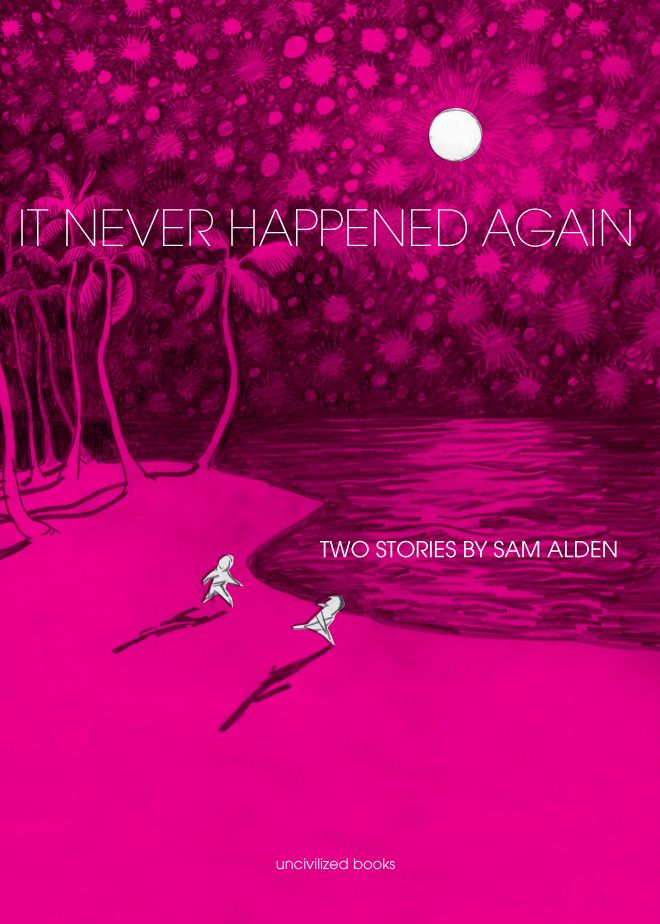It's not me this week. Instead, it's Greg Hunter. Greg writes about comics for THE COMICS JOURNAL and THE RUMPUS, so please know you're safely in the hands of someone who can do this. The best part? Greg's one of those writers who brings a fresh explanation to well-worn topics. I read his stuff and come away newly interested in things I'd already buried. Like Scott Snyder's BATMAN, even.
With the following piece, Greg provides this loose sentiment for Sam Alden's drawing approach. Alden is a young cartoonist who's already inspired much writing, but I like what Greg does here. He nails Alden's soft pencils into a well-described package and tumbles with the intentions behind the work. It's a quick piece, but it says what there is to say.
Where am I? Still here, driving trucks through the Twin Cities for money. I've read a pile of things I'm excited to write about. You'll know what they are next week.
In the mean time, hang out with Greg, and tell your mother you forgive her.
P.S. Full disclosure: I intern with Uncivilized Books, but I asked Greg to write about whatever he wanted, and he chose this book. This is not intended as a sleazy plug to impress the boss. Sam Alden is just really fucking good.
Sprezzatura - Greg Hunter
Sam Alden’s debut comics collection, It Never Happened Again, is divided into two stories - the internet hit “Hawaii 1997” and the previously unreleased “Anime”. But like most works that reward repeat readings, this book features stories within stories, rendered with thick, pencil lines that appear beautifully disordered.
One story within “Hawaii” is that of a young boy, possibly Alden himself, meeting a girl while on a Hawaiian beach. Another is the dynamic between Alden’s obvious chops and the looseness of the approach. Alden’s talent is evident from the first few panels of “Hawaii”—one might say it insists on identifying itself. In one standout sequence, Alden’s lead follows the girl as she runs through a grouping of trees, and Alden varies the shading and composition of the landscape—creating motion and space—in a manner that’s elegant, economical and compelling. His pencils serve the narrative in moments like this. “Hawaii” is a chase story, in part, and charged with uncertainty. The piece is so well realized, in fact, that maybe it’s only the appearance of hair on a few pages (as in, human or animal hair, scanned along with Alden’s art) that made me think about sprezzatura afterward.
Let’s call sprezzatura the projection of effortlessness. The notion comes from Castiglione’s Book of the Courtier, or at least that’s what I recall from English Lit I. Sprezzatura involves“a certain nonchalance,” Castiglione tells us, “so as to conceal all art and make whatever one does or says appear to be without effort and almost without any thought about it.” Picture the nobleman forcing a yawn during his lute solo, and you’ve pretty much got it.
I attended a reading by Alden last month. He was self-effacing, even bashful with respect to his work (which I guess could be a smokescreen, but let’s not allow analysis to give way to paranoia). At Minneapolis’s Boneshaker Books, Alden discussed pencil artwork as a means toward efficiency and spontaneity. But intention is only one of the factors that inform how we read stories like “Hawaii”. If Alden isn’t working to conceal his level of effort, his pencils still suggest a kind of sprezzatura comics.
If this sounds weird and circular, it is. “Hawaii 1997” can seem flashy and demonstrative because, upon first read, it refuses to exhibit those qualities. This is not a critique of Alden’s work (which I find quite moving in places, in addition to finding Alden impressive as a comics technician). Take it instead as a thought on proficiency—and on the complications that can develop when reading the work of an artist of serious skill. Or maybe even, on a more basic level, the effect a departure from a traditional element of a medium—ink, in this case—can have. Alden depicts movement, light and shadow, etc. so well that his very use of pencil generates a kind of tension—so well that a reader may be tempted to ask, ‘What’s really going on in this story?’
I mean, there are those hairs too, but I think a reader could ignore those and still wonder.
Follow Greg on Twitter. @gregjhunter


